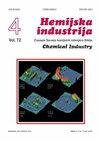Liquid transfer properties of textile fabrics as a function of moisture content
IF 0.8
4区 工程技术
Q4 ENGINEERING, CHEMICAL
引用次数: 4
Abstract
Liquid transport in textile fabrics determines thermal comfort during high physical activity of a person when liquid perspiration is produced and needs to be transferred away from the skin to keep the thermal balance. In this investigation, an attempt was made to get some indications of how the combination of the fabric composition, geometry and dimensional stability, and the moisture content influences liquid transfer properties of plain weft knitted fabrics. Therefore, the knitted fabrics made from pure hydrophilic (hemp fibres), pure hydrophobic (acrylic fibres) and a hydrophilic/hydrophobic (hemp/acrylic) fibre blend underwent a trial wear and care period. TheMaldenMills water distribution test was performed for the knitted fabrics with different moisture contents (0-30 %) in order to evaluate the effect on liquid transfer properties. Water transfer ability and water holding capacity of the knitted fabrics were also determined after undergoing the wear trial test. The obtained results were analysed with respect to macro and micro scales of porosity of knitted fabrics. It has been shown that the geometric configuration of the complex porous network in knitted fabrics influenced their liquid transfer properties in the whole moisture content range regardless of the composition. Despite the reconfiguration of the pore system in the knits during the trial period, their liquid transfer properties were still dependent on the pore size and distribution.纺织品的液体转移性能与含水量的关系
织物中的液体传输决定了人体在高体力活动时的热舒适性,此时会产生液体汗液并需要从皮肤中转移出去以保持热平衡。在本研究中,试图得到织物的组成,几何和尺寸稳定性,以及水分含量的组合如何影响平纹纬针织物的液体传递性能的一些迹象。因此,由纯亲水性(大麻纤维)、纯疏水性(丙烯酸纤维)和亲水性/疏水性(大麻/丙烯酸)纤维混纺制成的针织物经过了一段试验磨损和护理期。对不同含水率(0 ~ 30%)的针织物进行了TheMaldenMills水分分配试验,以评价其对织物液体传递性能的影响。通过耐磨性试验,测定了针织物的转水性和持水性。对所得结果进行了宏观和微观尺度的针织物孔隙度分析。研究表明,针织物中复杂孔隙网络的几何形态影响着针织物在整个含水率范围内的液体传递性能。尽管在试验期间,织物的孔隙系统发生了重构,但其液体传递性能仍然依赖于孔隙大小和分布。
本文章由计算机程序翻译,如有差异,请以英文原文为准。
求助全文
约1分钟内获得全文
求助全文
来源期刊

Hemijska Industrija
工程技术-工程:化工
CiteScore
1.60
自引率
11.10%
发文量
12
审稿时长
6-12 weeks
期刊介绍:
The Journal Hemijska industrija (abbreviation Hem. Ind.) is publishing papers in the field of Chemical Engineering (Transport phenomena; Process Modeling, Simulation and Optimization; Thermodynamics; Separation Processes; Reactor Engineering; Electrochemical Engineering; Petrochemical Engineering), Biochemical Engineering (Bioreactors; Protein Engineering; Kinetics of Bioprocesses), Engineering of Materials (Polymers; Metal materials; Non-metal materials; Biomaterials), Environmental Engineeringand Applied Chemistry. The journal is published bimonthly by the Association of Chemical Engineers of Serbia (a member of EFCE - European Federation of Chemical Engineering). In addition to professional articles of importance to industry, scientific research papers are published, not only from our country but from all over the world. It also contains topics such as business news, science and technology news, information on new apparatus and equipment, and articles on environmental protection.
 求助内容:
求助内容: 应助结果提醒方式:
应助结果提醒方式:


